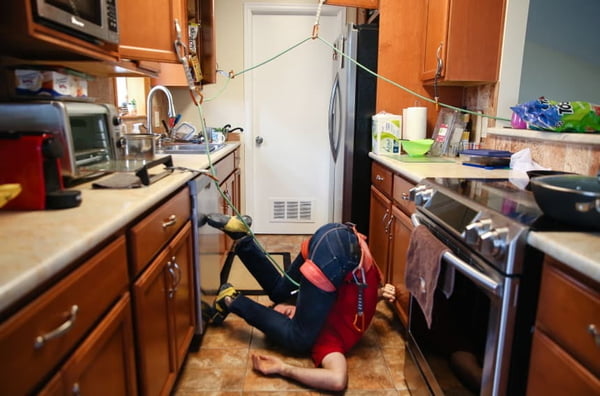
Daily Mountain
48 years, Australia
Search and Rescue Groups Urge People to Stop Climbing Cabinetry During Pandemic
This article first appeared on http://www.climbing.com. The original can be read here.
Climbers have largely heeded the call to curb their outdoor pursuits during the COVID-19 pandemic. The move encourages social distancing and prevents accidents which could further stress our medical system. Unfortunately, according to Search and Rescue (SAR) groups, climbers haven't stopped climbing. They've merely taken the sport home: to their kitchens, fireplaces, and brick exteriors. Now those SAR teams are responding to an alarming number of home climbing accidents.
 Credit: Kevin Corrigan
Credit: Kevin Corrigan
"The most common are floorfalls, for sure," said Krista Layton, a Denver SAR volunteer. "People overestimate the holding power of a quickdraw clipped to a toaster-oven handle, or a cam slotted between a washer and dryer, and they get overconfident. They try a move that's at their limit—maybe they dyno for the kitchen island and come up short—then all their pieces pull and they hit the tiles. That's when we get the call."
The trend has become so popular that SAR teams are overwhelmed.
"Last night we were responding to a call from a climber trapped on a shelf two feet above the backsplash and unable to locate a descent path," said Layton, "when we received another call about a climber that had become stuck while chimneying her chimney. I haven't slept in days. It's kitchen, after kitchen, after kitchen."
According to Layton, most calls are not serious as falls rarely exceed three feet. It's the sheer volume that is a problem. "It's literally every climber—every one of them—that's climbing their house," she said. "My entire Instagram feed has been consumed by these photos, save for my one aunt who posts vegetables she's excited about. I really appreciate her right now." Layton says that this has been going on for weeks, with no end in sight.
Climbers are seemingly taking precautions for these routes. They don harnesses, often wear a helmet, rope up, and clip protection. Some have even been seen carrying full alpine packs, prepared to bivvy during an extended ascent should the need arise. Yet, there is rarely a belayer present.
"It's curious," said Layton. "It's almost as though they're mock leading or free solo trad climbing. It has all the appearance of safety, yet the rope is just for show."
The location of these accidents can present unique logistical challenges to rescuers.
"Every kitchen climbing victim must be reached on foot," explained Layton. "Because helicopters cannot fly indoors."
And while most climbers have escaped their ordeals with minor injuries, there have been tragedies.
"We responded to one call for a climber that was traversing a monolithic feature when it toppled over and landed on her—it was a Frigidaire," Layton said. "And another climber severed his rope when he pulled the knife drawer out then decked onto the knives, and then more knives fell on him. Those weren't rescues, they were body recoveries."
These more grisly accidents can can leave SAR members with lasting trauma.
"Every night I have dreams about the woman whose rope was wrapped around the ceiling fan when her roommate walked into the room, and without thinking... I'm sorry, I can't," said one SAR volunteer who asked not to be identified.
Layton stressed that, under normal circumstances, they would encourage inexperienced climbers to hire a guide to learn the necessary skills before traversing a countertop. Now, that's not possible, so her team is instead encouraging climbers to abstain from climbing. If not, she believes that one day there will be a reckoning.
"This may seem fun now, but someday you're going to move out of that apartment, and you are not going to get your security deposit back."





